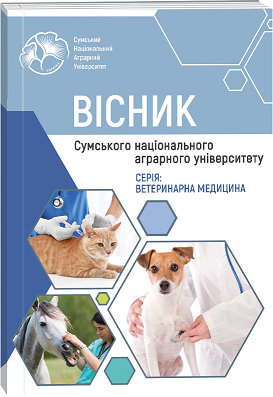Вивчення відтворювальної здатності кролематок гібридних кросів при використанні штучного осіменіння у комплексі з гормонотерапією в умовах приватної кролеферми
Анотація
У статті подано інформацію щодо технологічного процесу штучного осіменіння кроликів (ШО): отримання сперми, оцінка якості еякуляту та його розведення, оцінка технологій введення сперми у статеві шляхи самок що були проведенні на базі приватної кролеферми, яка спеціалізується на розведенні гібридних кросів кроликів, а саме ліній HYPLUS. Ефективність ШО залежить на сам перед від якості батьківського поголів’я та методу введення сперми. Вагінальне введення є найбільш простим і найменш інвазійним методом. Перед проведенням ШО усіх тварин необхідно обстежити з метою виключення фізіологічних відхилень. За для отримання максимальних показників усіх кролиць запліднюють у період статевої охоти, синхронізація якої досягається введенням гормональних препаратів на основі сироватки гонадотропіну жеребних кобил (ГСЖК). Ефективність використання препарату визначається за допомогою зовнішнього огляду статевих органів. Для осіменіння обираються кролиці з вираженою припухлою, овальною петлею, яскраво червоного або бузкового кольору складчастість слизової оболонки якої добре виражена. Значним фактором в успішності ШО є вибір оптимального часу. Найбільш ефективним за часом осіменіння необхідно проводити не пізніше ніж за 30-60 хвилин після отримання сперми її оцінки і розведення. Оптимальна ступінь розведення сперми визначається за її якістю і густотою. Сперму у кроликів поділяють на три типи: густу, середню і рідку. Для розведення використовують різноманітні розчинники, які мають у своєму складі речовини для підтримання енергетичного балансу сперматозоїдів, буферні компоненти, солі, комплекс антибіотиків широкого спектру дії та компоненти для підтримання осмотичного тиску та стабілізації кислотності (рН). Для введення сперми використовують спеціалізовані одноразові катетери, після чого необхідне внутрішньо м’язове введення синтетичного нанопептиду, аналогу гонадотропін-релізінг гормону ЛГ-РТ-люберина для стимуляції виходу зрілих яйцеклітин з яєчників у статеві шляхи кролиці. Для одержання прибутків і швидкості відтворення поголів’я було розроблено найбільш ефективну методику відтворення з використанням гормональних засобів Фоллігон, Сергон 500 і Сурфагон за оптимальною схемою і дозами, та використання напів щільних окролів для максимальної ефективності і недопущення виснаження маточного поголів’я.
Посилання
Studencov, A.P. (1999). Veterinarnoe akusherstvo, ginekologiya i biotehnika razmnozheniya.[Veterinary obstetrics, gynecology and biotechnology of reproduction.], Kolos. 495.
Norejko, A.Y. (2013). Iskusstvennoe osemenenie-perspektivnoe napravlenie pri razvedenii myasnyh porod krolikov. [Artificial insemination-promising direction in the breeding of meat breeds of rabbits]. Naukovij visnik Nacionalnogo universitetu bioresursiv i prirodokoristuvannya Ukrayini. Ser.: Tehnologiya virobnictva i pererobki produkciyi tvarinnictva [Scientific Bulletin of the National University of Life and Environmental Sciences of Ukraine. Ser .: Technology of production and processing of products of farming], 190, 279-286.
Moreva S.A. (2017). Isskustvennoe osemenenie krolikov [Artificial insemination of rabbits]. Molodezh i nauka [Youth and science], 4.1, 48-48.
Ekimova A.A. (2020). Iskusstvennoe oseminenie krolikov. [Artificial insemination of rabbits]. Molodezh i nauka [Youth and science], 2, 18.
Pabat V.O., Vinnichuk D.T., Goncharenko I.V., Agij V.M. (2018). Krolivnictvo z osnovami genetiki ta rozvedennya : navch. posib [Rabbit breeding with the basics of genetics and breeding: textbook]. Kyiv: Lira Publishing House, 164.
Plotnikov, V. G. (2010). Evolyuciya tehnologij v krolikovodstve [Evolution of technologies in rabbit breeding]. Krolikovodstvo i zverovodstvo [Rabbit breeding and fur animal husbandry], 1, 17-22.
Pozdnyakova, V. F., Anfimova, A. M., Bravilova, E. A., & Pinkus, A. I. (2018). Iskusstvennoe osemenenie krolchih na promyshlennyh kompleksah. [Artificial insemination of rabbits on industrial complexes]. www.issledo.ru Redakcionnaya kollegiya, 94.
Zdanovich, S. N., Dobudko, A. N., Kostenko, A. Yu., & Hohlova, T. N. (2019). Ocenka vosproizvoditelnoj sposobnosti krolchih porody Hikol, myasnogo napravleniya produktivnosti, pri ih iskusstvennom osemenenii [Estimation of reproductive ability of rabbit breeds Hikol, meat direction of productivity, at their artificial insemination]. Aktualnye voprosy selskohozyajstvennoj biologii [Current issues of agricultural biology], (3), 48-58.
Lisin, V. I., & Sushko, A. B. (2013). Rezultaty primeneniya Surfagona v praktike iskusstvennogo osemeneniya krolikov [The results of the use of Surfagon in the practice of artificial insemination of rabbits]. Naukovo-tehnichnij byuleten [Scientific and technical bulletin], Lviv, 109 (1), 174-181.
Pecsi Tamas (2007). Hazi emlosallatok mesterseges termekenyitese. Debrecen. Mezogazda Kiado, 411.
Agij, V.M., Nod, F.K., Griga, N.P. (2011). Teoriya ta praktika novoyi reproduktivnoyi tehnologiyi u krolivnictvi [Theory and practice of new reproductive technology in rabbit breeding]. Naukovo-tehnichnij byuleten [Scientific and technical bulletin], Lviv, 1–2, 12, 394–398

Ця робота ліцензується відповідно до Creative Commons Attribution 4.0 International License.

 ISSN
ISSN  ISSN
ISSN 



